Eternal Flame, Nameless Tower - climbing history and Alexander Huber interview
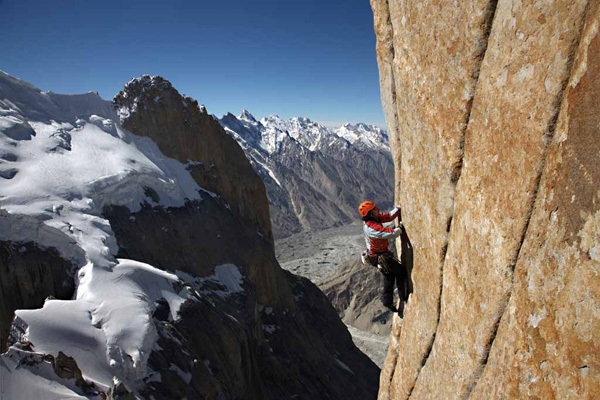
 1 / 18
1 / 18 Hinterbrandner / Huberbuam.de
Hinterbrandner / Huberbuam.de
Summer 1989. During an intense two month period a four man expedition comprised of some of Germany's finest free climbers, namely Kurt Albert, Wolfgang Güllich, Christof Stiegler and Milan Sykora, forged a new line they had spied the previous year up the 6251m high Nameless Tower in the remote Trango Tower region of Pakistan's Karakorum.
The first ascent proved difficult to say the least as the four battled hard against poor weather, snowfall and avalanche danger just to establish camp on the south shoulder, the so-called Sun Terrace at 5500m from where the route true-and proper begins. After seven weeks plastic boots were finally traded for climbing shoes and the next morning the four alpinists were greeted with a magnificent sunrise. The tower blazed red, providing the route with its name and as Kurt Albert later wrote, this name was also intended to reflect that driving motivation, that mad passion which blazed within all four of them and which helped wipe away the immense physical hardship.
As the sun rose a blank section right at the start provided cause for concern and had reluctantly to be overcome with the use of aid. After climbing the first pitches and installing fixed ropes the team rested in base camp for two days before setting off for their summit push. Things ran smoothly up perfect granite cracks but disaster struck just below half height: Güllich fell from “Am I only dreaming” and severely injured his ankle. Later at home he was to be diagnosed with torn ankle ligaments forcing him into weeks of rest, and at almost 6000m in the Karakorum this injury almost certainly spelled the end to the expedition. The team brought Güllich down to safety at the shoulder camp and and were agonised by the thoughts of dashed redpoint dreams. But things were to turn out differently.
Güllich rested in the camp and while he alleviated his pain with aspirin and ice, Albert and Stiegler continued upwards into new terrain. Shortly after mid-height they traversed right into the Yugoslav route and, thanks to some risky climbing, reached the summit on 18 September, just as porters arrived in base camp. Perfect timing for Stiegler and Sykora who had to return to Germany; Albert and Güllich however remained, in the hope of giving the climb one last shot.
The two dreamt of completing their ideal line, of forging another 200 independent meters to the summit. Güllich with torn ankle ligaments, Albert at the end of his reserves after having climbed numerous days without resting... the task they had set themselves was formidable. Yet against all odds the duo established what are now considered the most beautiful pitches of the entire route, “You belong to me” and “Say my name” as well as the crux “Sunshine through the rain”. Climbing for six days on the trot, Albert then aided two more pitches and, after having risked an extremely dangerous fall near the top, the two reached easier terrain which led to the summit. Their dream had come true and their Eternal Flame paved the way for a new dimension of sport climbing in the Greater Ranges.
7b+ at 6000m, with four sections of aid still to be freed. An irresistible seed had been sown, a challenging gauntlet had been thrown down with this monumental climb and Eternal Flame immediately became a prized object, a sought after goal for some of the world's best alpinists. Over the next two decades capricious weather, the altitude, iced cracks, freezing temperatures combined with the sheer technical difficulties of the climb always resulted in attempts being abandoned. But some significant steps forward were made, notably in 2003 when Toni Arbones from Spain teamed up with the Swissmen Denis Burdet and Nicolas Zambetti. After 17 days on the wall the trio managed to free the two upper aid pitches, but the blank section in the middle remained unclimbable. In 2005 the Spanish brothers Iker and Eneko Pou discovered a hard bouldery variation to the 10th pitch, but bad weather pinned them down and they were eventually forced to give up hopes of the redpoint. It was only a matter of time, and luck, before someone would manage to free climb all 750m.
Summer 2009. In August this year the time was finally ripe. Aided by perfect weather AlexanderHuber and Thomas Huber, two of the world's strongest, most experienced and respected free climbers, made incredibly swift progress. They reached the sun terrace in a mere 7 days and over a four day period of stunning weather successfully completed the first free ascent of the route. This came about thanks to a free variation to the start and a variation to the crux pitch at mid-height which avoided the blank and wet bouldery crux. Just after midday on 14 August the two reached the summit at 6251m, having climbed all pitches free, 650m up to 7c+. The final piece in the jigsaw puzzle had finally fallen into place.
The Hubers' vertical experience is second-to-none and ranges from massive climbs in the Alps and Dolomites to Yosemite, Patagonia, the Himalaya and even the Antarctic. On returning to his home in Berchtesgarden in Germany, Alexander stated “I take my hat off to the achievement and free climbing instinct of the first ascenders. This route is a true enrichment for mountaineering. With "Eternal Flame" Kurt Albert, Wolfgang Güllich, Christof Stiegler and Milan Sykora have passed on the best and most beautiful free climb on the globe. We are thrilled that we could play a little part in developing this route!" Alexander Huber's excitement was palpable. He has now given us the following insight into this fantastic, landmark achievement.
Alexander Huber interview, Eternal Flame Nameless Tower
Congratulations Alex. In all honesty, did you ever dare dream of such a fantastic ascent?
I'd dreamt about climbing this route free for a long time. Over the years various teams had returned home unsuccessfully and so this year we got our chance! I wasn't totally surprised by our ascent. At times we've had to wait for an long time and returned empty handed, other times things have run smoothly. This time we were lucky, it was fantastic, superb. But next time, who knows?
What was the hardest things you encountered?
The hardest is certainly having all the right prerequisites for a successful ascent. You have to be fit enough for the climb, need a fair experience of climbing in the Alps, everything has to be organised well and last but not least you need to be lucky with the weather. When you're out there you need to believe in your own abilities and push yourself...
The route dates back to 1989...
What impressed me most of all was the failess instinct they had to find the best line on the entire mountain. The last pitches in particular are brilliant, the work of genius...
How important is it for you, that you climbed a route first ascended by these four climbers?
Kurt Albert and Wolfgang Güllich have always been our absolute free climbing heroes. It's an honour for us to be linked to them a little bit by managing to be the first to free their route.
Eternal Flame is situated between 5000 and 6000 meters. How much do you need to be a sport climber, and how much a mountaineer, to master this route?
The route in itself is relatively safe as the rock is extremely compact, but it certainly isn't a “plaisir route”. It's a demanding alpine outing, where you really have to know how to place trad gear. I'd say that the technical climbing difficulties are certainly far harder than the mountaineering difficulties: Nameless Tower isn't a complex mountain, you don't have to navigate through difficult icefields or across avalanche prone slopes. Having said that though, the mountain reaches 6251m in height so you need to acclimatise properly, you need to know how your body reacts at altitude, when you can accelerate and push yourself, and when it's wiser to turn back.
You climbed the route over four days and abseiled back to the shoulder at the end of day. Why no portaledge?
It was a lot simpler for us to abseil down to the Sun Terrace and jumar back up to our highpoint the next day, rather than doing without jumars altogether. Otherwise we would have had to bivvy in portaledges at our highpoints, but this would have involved more effort.
Can you imagine that someday someone will climb the route in a single day?
Analysing the technical difficulties, this really isn't a problem. But on a route like this external factors play a huge role, such as the temperatures and meltwater, which means it's above all down to luck whether one manages or not...
You added some variations to free the route. Can you envisage that the original pitch “Eternal Burning” ever going free?
No, I can't. That bolt ladder is quite simply unclimbable.
What do the Hubers watch out for during their ascents?
What's important for us is to redpoint the entire line as a team. Each pitch free, both of us. We both climbed the entire route free from 11 – 14 August and we managed to on-sight most pitches. Those few that we didn't, we managed to redpoint second go.
Güllich and Albert travelled to the Trango in 1988, freed the Yugoslav route and returned in 1989 to establish Eternal Flame. Will you be going back to there to create something new?
From our point of view we've climbed the best route, the best line on the entire mountain and we therefore won't return. There are simply far too many other interesting mountains out there.
7b+, A2 at 6000m in 1989. How much has Himalayan big wall climbing developed over the last two decades?
Of course climbing has continued to evolve in the Himalaya, but not in the same measure as in the Alps or Yosemite. What Kurt Albert and Wolfgang Güllich achieved was truly groundbreaking and at the time far more “ahead of its time” than our redpoint ascent today. Having said that, I'm convinced that Eternal Flame is currently the hardest free climb in the Himalaya and Karakorum.
Eternal Flame
S. Buttress, Nameless Tower, Trango, Karakorum, Pakistan.
First ascent: Kurt Albert, Wolfgang Güllich, Christof Stiegler, Milan Sykora, 09/1989
Original grade: VI, 7b+, A2.
First free ascent: Thomas & Alexander Huber 11-14/08/2009
Grade of route: 7c+
Length: 650m
Number of pitches: 24 pitches
Altitude: 6251m
Nameless Tower
Nameless Tower, or more simply known as Trango Tower, was first ascended in 1976 by the British climbers Joe Brown, Mo Anthoine, Martin Boysen, and Malcolm Howells after an epic unsuccessful attempt the previous year. Mo Anthoine and Martin Boysen reached the summit on 8 July while Joe Brown and Malcolm Howells summited the next day in worsening weather. The British route was graded VI, 5.10 A2, 1100m with circa 80% climbed free - at the time it involved some of the hardest rock climbing ever achieved at altitude. The Tower received its second ascent 11 years later by a Yugoslav team led by Slavko Cankar.
| Links Planetmountain | |
| News Huber | |
| Alexander Huber interview | |
| Links Expo.Planetmountain | |
| Expo La Sportiva | |
| Links www | |
| www.huberbuam.de | |



 Copia link
Copia link


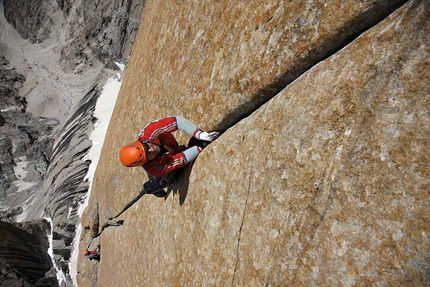
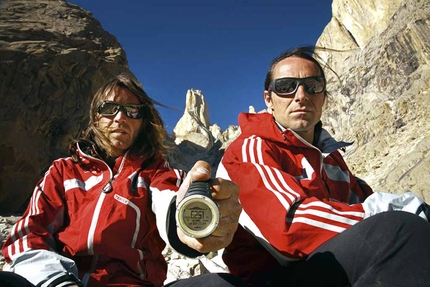
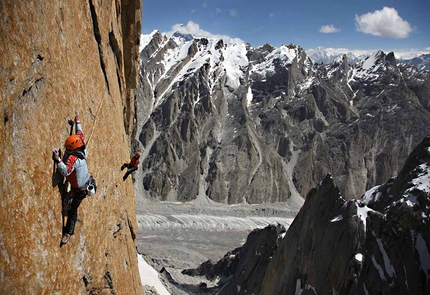
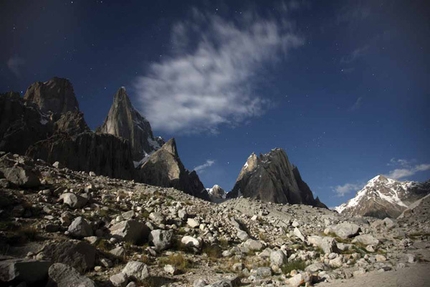
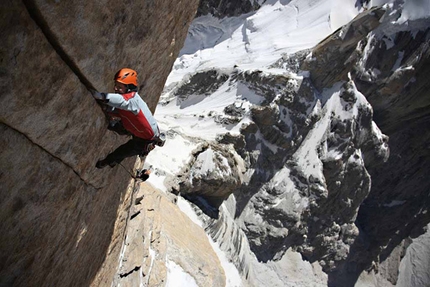
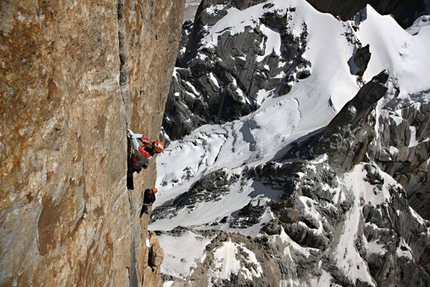
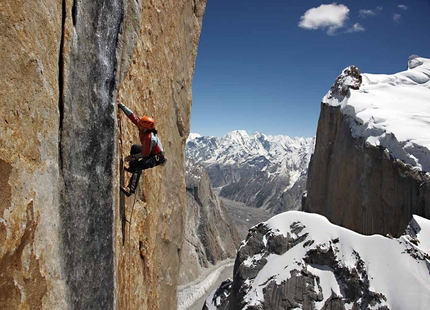
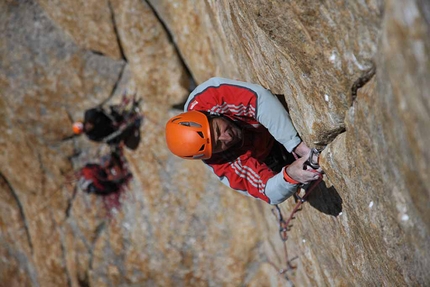
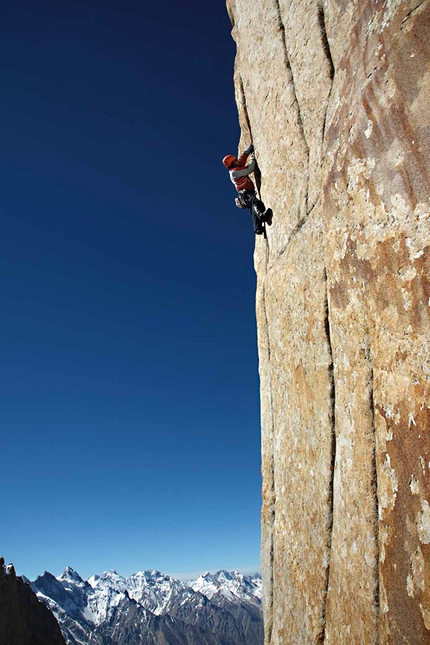
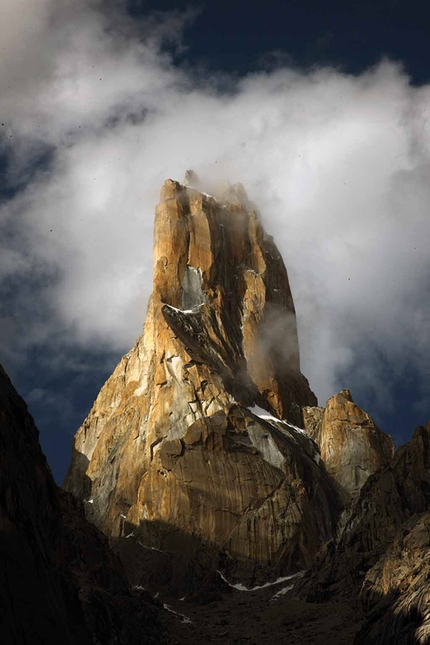

 See all photos
See all photos






















